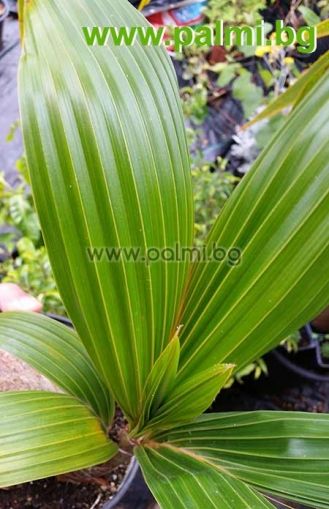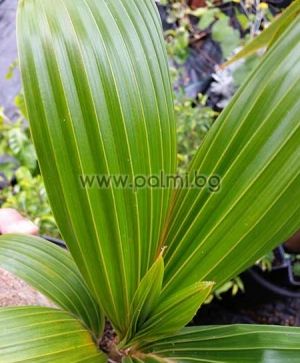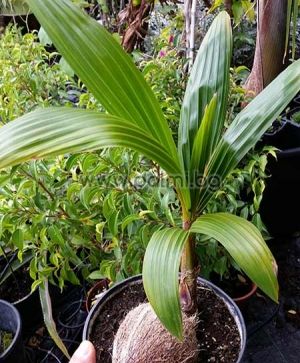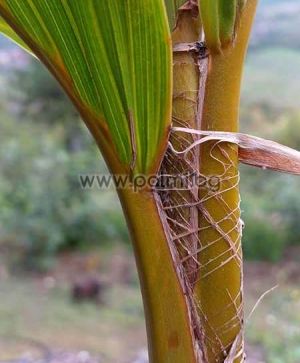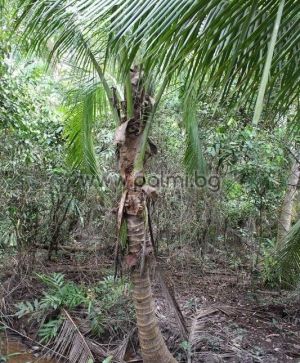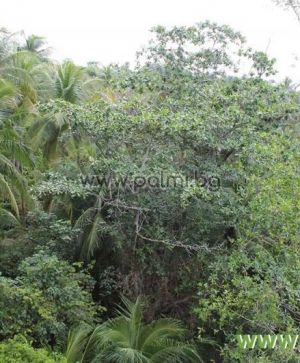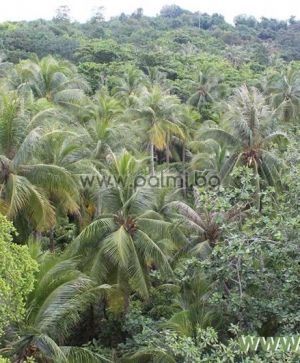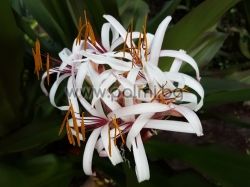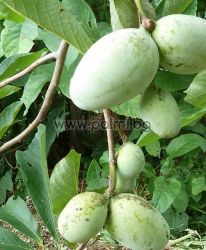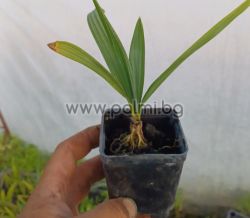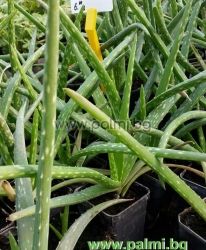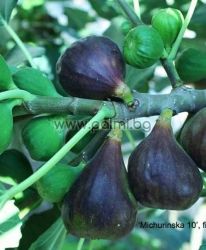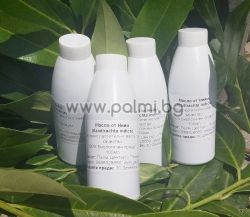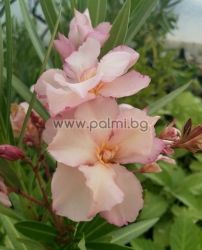Coconut palm
-
Code:Cocos nucifera
-
Gewicht:3.000 Kg
These palms are grown in Bulgaria from coconuts, imported from South Africa. You can only find them in our nursery! They are grown outdoors in summer and indoors in winter, but never been in a greenhouse, so they are adapted to conditions, similar to those at home.
Coconut palm is not only among the most economically important plants on earth, but is perhaps the most beautiful of them. They are a symbol of tropics, exotics, romantic beaches and nice vacation.
In the last 15-20 years in Bulgaria were imported large amounts of coconut palms from the Netherlands. They are always of the green form, but this is not so important. Due to the complete incompetence of most sales persons at the flower shops, buyers of these palms get completely wrong tips for growing them. The result is the killing of almost all those palm trees, and people having the impression that coconut palms are very difficult to grow.
The truth is that Coconut palms are among the easiest palms to grow But most importantly, they need warmth. Temperature should not fall below +18°C! They should be watered regularly, because they do not like drought. If a sunny south window is provided, they will grow all winter. And during the period May 15 to September 15 should be out in just a little shading.
More information is available in our forum:
http://forum.palmi.bg/viewforum.php?f=38
Below is our article about growing a Coconut palm:
For most of the tropical plants grown at home persist various legends, in most cases the writings on the Internet is bordered by stupidity. " Authors " have copied verbatim separate texts and created a completely wrong idea of growing plants without ever having a real experience with them . The fact that almost no one has been able to grow coconut palms (Cocos nucifera L.) at home in Bulgaria shows the lack of information on its cultivation. The purpose of this article is to provide guidance for the cultivation of Coconut palms.
Everyone has different potted plants at home. It is important to know each plant's origin. This gives us and idea about the growing requirements. The information is now more accessible than ever before.
Coconut palm is an extremely beautiful plant native to islands in the tropical zones of the oceans and seas. But they grow also deep inland and near the  equator grows to about 1000 meters above the sea level. To such an altitude temperatures are about 5 degrees lower compared to the beach and coconut palms literally suddenly disappear around 1000-1050 m. This shows how important are the high temperatures.
equator grows to about 1000 meters above the sea level. To such an altitude temperatures are about 5 degrees lower compared to the beach and coconut palms literally suddenly disappear around 1000-1050 m. This shows how important are the high temperatures.
Coconut plantation in Indonesia >
Coconut palms that are sold in our country are exclusively from the green form. They grow faster and therefore are less expensive, but for growing in a pot, far more suitable is the orange form, that originates from Southeast Asia.
Orange and green fruit of the Coconut palm >
Orange form has a much longer life in a pot and due to its small size, manages to establish a beautiful crown - something otherwise difficult to achieve in a pot.
Coconut palm with orange fruits >
Characteristic of the orange form of the Coconut palms are the orange leaf petiole, orange fruits (Coconuts), a light green color of the leaves as well as the smaller size of the tree compared to the huge palm trees on the green form. The orange Coconut palm never exceed 10 meters in Indonesia, but the green varieties grow more than 25-30 meters.

< Coconut palms of the green form, imported from Holland, raised for over two years indoors in Bulgaria. Note the thickness of the stem achieved in two years and leaves that are starting to be "cut." Lower down are visible orange palms, that of much smaller size have already leaves as an adult plant.
Coconut palm Malayan Dwarf Gold, grown for many years in a pot >

You can distinguish Coconut palm leaf by the channels upside down, compared to the Date palm. >
A plant of tropical origin has completely different requirements for temperature compared to those with subtropical or Mediterranean origin. In tropical conditions nighttime temperatures never fall below 22-24°C, and are daily over 24°C. Requirements of both forms of the Coconut palm are the same - namely, minimum average temperature of 20°C. This means that if during the day you achieve 22°C, at night it should not fall below 18°C.
A Coconut palm in a pot. ^
The most important thing you need to know about the cultivation of the Coconut palm is that it does not tolerate cool temperatures, what goes about the cold!
Acceptable minimum temperatures and their duration for the Coconut palms
|
Temperature |
Maximum acceptable duration without damages |
Results after longer exposure |
|
below +20°С |
1 month |
Growth fully stops |
|
below +18°С |
7 days |
slowly die-off of the leaves |
|
below +15°С |
3 days |
die-off of the leaves |
|
below +10°С |
24 hours |
rotting of the central growing bud |
|
below +5°С |
3-5 hours |
The plant and all leaves die. |
|
below 0°С |
not a second |
Instant death of the plant |
Coconut palms are slow-growing. This means that we have no right to experiment - if damaged, the leaves will take many years to recover. Furthermore, in all evergreens, leaves act as a depot for nutrients, if you deprive the plant of leaves, you deprive it of food supplies. The leaves produce substances needed to produce new leaves, so if there are no old leafs, there will be no new ones.
Since growth stops completely at temperatures below +20°C and below +18°C the leaves start to get damaged, we should not allow night temperatures below +18°C. Daily temperatures should always be above +20°C. If growth stops completely for longer time, it means the death of the plant.
Requirements to light are great . Coconut palms must be places next to the most bright window. During the period May 15 to Sept 15, the palm trees can be moved outside. If you are at an altitude of over 600 meters , it is better to keep your palm inside all year round, due to the very low night temperatures outside even in the summer. Black Sea coast conditions allow the Coconut palms to grow out of at least May 15 until at least September 15. The growth in the summer there, is the best compared to the rest of Bulgaria . Whem moving outside, never leave the plant under the direct sun during the hottest hours - leaves formed in the room will easily burn. Use light shading or eastern exposure.
Even as you may think, that moving of the Coconut palm outside in summer, believe that the effort is worthwhile. Thus, the stem becomes thicker, the leaves become shorter. The crown becomes more dense and beautiful.
In the summer water every day. When indoors, water after slight drying of the soil surface. The plate should not hold water for long.
Fertilizing is important all year round. Without fertilizing, growth is weaker and the plant fails to develop its potential because the roots are confined in a pot. The slow release fertilizers do a good job, but whatever you decide to buy - follow the instructions on the label and avoid over-fertilizing!
The size of the pot should not be increased too quickly, or transplanting in just 2-3 years will become an adventure. Transplant once every 1-3 years, always in early June. A new pot must be of 3-5 cm larger in all directions. When transplanting, do not touch the roots nor cut them! Carefully add the new substrate and water thoroughly. The type of substrate is not so important - any good substrate from the store will do the job.
The orange form of the Coconut palm is extremely difficult to find in Europe.
Everything written above is true for most tropical palms, like the genus: Licuala, Hyophorbe (Mascarena), Pritchardia, Roystonea, Veitchia, Wodyetia, Areca, Chrysalidocarpus, Ravenea etc.
Everything written above IS NOT TRUE for the subtropical and Mediterranean palms, like the genus: Trachycarpus, Chamaerops, Phoenix, Washingtonia, Butia, Jubaea, Sabal, Chamaedorea, Kentia (Howea), Archontophoenix, Rhapis, Brahea (Erythea), Trithrinax, Nannorhops, Rhapidophyllum. They have different growing requirements.
This article can be copied to other websites or any other type of publishing only if the whole article is copied, including the pictures and only if the author's name is written, together with this link: http://www.palmi.bg
Author: Kiril Donov
Geschätzte Versand
 Kurier nach Plovdiv
€3.11
Kurier in Bulgarien
€3.11
Kurier nach Plovdiv
€3.11
Kurier in Bulgarien
€3.11
 DPD Kurier nach EU Zone beginnt ab
€15.28
DPD Kurier nach EU Zone beginnt ab
€15.28
 DPD Kurier nach EU Zone beginnt ab
€32.21
DPD Kurier nach EU Zone beginnt ab
€32.21
-
USDA- Klimazone:+17°C (Zone 13b)
-
Sonneneinstrahlung:teilweise Sonne
-
Boden-pH:nicht wichtig
-
Wasserbedarf:feuchtigkeitsliebende
-
Kategorie:Tropische Palmen
-
im Boden:In Topf nur

